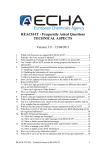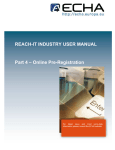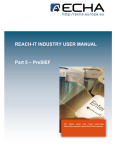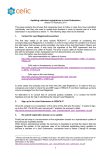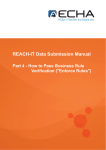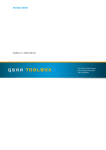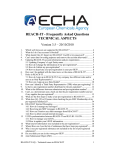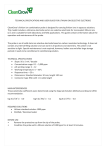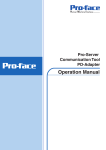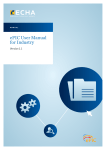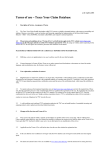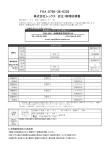Download Questions and answers on inquiry and substance
Transcript
Questions and answers on inquiry and substance identification For the latest news and the most up-to-date information, please consult the ECHA website. LEGAL NOTICE This Questions and Answers document contains information on obligations under the REACH Regulation (hereafter referred to as REACH or the REACH Regulation) explaining how to fulfil them. This Q&A document has been generated by the European Chemicals Agency (ECHA). However, users are reminded that the text of the REACH Regulation (Regulation (EC) No 1907/2006 of the European Parliament and of the Council of 18 December 2006 concerning the Registration, Evaluation, Authorisation and Restriction of Chemicals (REACH), establishing a European Chemicals Agency, amending Directive 1999/45/EC and repealing Council Regulation (EEC) No 793/93 and Commission Regulation (EC) No 1488/94 as well as Council Directive 76/769/EEC and Commission Directives 91/155/EEC, 93/67/EEC, 93/105/EC and 2000/21/EC) is the only authentic legal reference and that the information in this document does not constitute legal advice. The European Chemicals Agency does not accept any liability with regard to the contents of this document. Questions and answers on inquiry and substance identification Reference: Publ.date: Language: ECHA-11-QA-02-EN June 2011 EN The European Chemicals Agency (ECHA) is producing this document to inform interested readers about the background to and basic provisions of Regulation (EC) No 1272/2008. If you have questions or comments in relation to this document please submit them (quote the reference and issue date) using the information request form (quote the reference and issue date). The information request form can be accessed via the Contact ECHA page at: http://echa.europa.eu/about/contact-form_en.asp © European Chemicals Agency, 2011 Reproduction is authorised provided the source is fully acknowledged in the form "Source: European Chemicals Agency, http://echa.europa.eu/", and provided written notification is given to the ECHA Communication Unit ([email protected]). European Chemicals Agency Mailing address: P.O. Box 400, FI-00121 Helsinki, Finland Visiting address: Annankatu 18, Helsinki, Finland Questions and answers on notifications on inquiry and substance identification Table of contents GENERAL............................................................................................................................. 1 1. I submit my inquiry dossier to ECHA. What happens next?............................................................................ 1 2. Do I have to wait for the result of my inquiry before submitting my registration? ............................................ 1 3. I need to update my registration as a result of a tonnage band increase; do I need to submit an inquiry?..... 1 4. How do I submit an inquiry due to tonnage band increase? ........................................................................... 1 5. What is the confidentiality of the information submitted for an inquiry? .......................................................... 2 6. When will I receive the details of other potential and previous registrants?.................................................... 2 7. ECHA was not able to process my first inquiry due to missing and insufficient information and requested me to submit a new one. Do I have to state the submission number from my previous inquiry in my re-submission? ............................................................................................................................................................................ 3 8. My inquiry could not been processed by ECHA due to insufficient/inconsistent information. Is there a deadline for re-submitting an inquiry?................................................................................................................. 3 9. How does the Third Party Representative (TPR) function work for inquiry? ................................................... 3 10. ECHA has indicated some changes to be done in our inquiry dossier but has provided us with an inquiry number. Do I have to re-submit my dossier? ...................................................................................................... 3 11. What is the deadline for processing inquiries?.............................................................................................. 3 12. Do I have to specify a production site if I am an importer or only representative? ........................................ 3 STUDY SUMMARIES AND DATA SHARING....................................................................... 4 1. Can I begin vertebrate testing before I receive the result of my inquiry? ........................................................ 4 2. We have received an inquiry number and contact details of previous registrants. What to do next?............. 4 3. I am having difficulty gaining cooperation from a previous registrant. What can I do?.................................... 4 4. I, as a previous registrant, have received a letter from ECHA informing me about an inquiry on a substance I registered. What to do next?............................................................................................................................... 5 INTERMEDIATES ................................................................................................................. 6 1. I am a potential registrant of an intermediate. Where can I specify this fact in my inquiry dossier?................ 6 2. I am a potential registrant of an intermediate. Do I have to submit spectral data and analytical information as part of my inquiry dossier even though I do not require this information for the registration? ............................. 6 SUBSTANCE IDENTITY....................................................................................................... 6 1. Why do I need to provide analytical information? Is CAS/IUPAC name not enough to verify the substance identity? .............................................................................................................................................................. 6 2. How do I specify unknown impurities of well-defined substances?................................................................. 6 3. What spectral data does ECHA require for inquiry? ....................................................................................... 7 4. Why do you require ultra-violet and nuclear magnetic resonance spectra when infra-red spectrum is enough to identify the substance? ................................................................................................................................... 7 5. The substance contains an anionic and cationic part. Do I have to provide analytical data for the identification of each ion? ................................................................................................................................... 8 6. Is it possible to get access to the analytical information for the substance we inquire about? ........................ 8 7. Where can I find further information which would help me in preparing my inquiry dossier?.......................... 8 Questions and answers on notifications on inquiry and substance identification GENERAL 1. I submit my inquiry dossier to ECHA. What happens next? Once ECHA has received your inquiry dossier it will go through some mandatory submission checks and then the dossier will be assessed. If ECHA is able to process your inquiry dossier, you will receive via REACH-IT a communication which states your inquiry number and information on previous registrants and other inquirers of the same substance as well as details of available (robust) study summaries, as appropriate. If ECHA is not able to process your inquiry dossier, due to insufficient and/or inconsistent information provided on substance identification, you will receive via REACH-IT a communication detailing additional information required. You will then need to prepare a new inquiry dossier including the information requested in the communication and submit it to ECHA. We recommend when submitting a new inquiry dossier to state the previous submission number in the dossier header as such information is useful to ECHA and it may facilitate the processing of your inquiry. 2. Do I have to wait for the result of my inquiry before submitting my registration? Yes, you need to wait until you have received a communication from ECHA stating your inquiry number before submitting your registration as you may have legal obligations to submit a joint registration and share data. The communication will also contain details of previous registrants and inquirers (if any) as well as a list of (robust) study summaries available in ECHA, as appropriate. 3. I need to update my registration as a result of a tonnage band increase; do I need to submit an inquiry? If you do not need additional information, as a result of a tonnage band increase, you should not submit an inquiry to ECHA. However in the case where you need additional information to meet the requirements for the new tonnage band you are requested to submit an inquiry to ECHA. 4. How do I submit an inquiry due to tonnage band increase? For inquiries as a result of a tonnage band increase, ECHA strongly recommends use of the online dossier creation tool as only the registration number for which the tonnage band increase relates to, the tonnage band and the information requirements need to be specified. For guidance on how to create online an inquiry dossier for a tonnage band increase, please refer to chapter 4.4.1 of the Industry User Manual – Part 11 (Online dossier creation and submission for inquiries) which you can find on the following website: http://echa.europa.eu/doc/reachit/industry_user_manual/reachit_online_dossier_creation_inq uiry_en.pdf Alternatively, you can submit the inquiry as a IUCLID dossier via REACH-IT. The IUCLID inquiry dossier needs to contain as a minimum the following information: 1 Questions and answers on notifications on inquiry and substance identification o Section 1.1 of the substance dataset The IUPAC name and EC number o Section 1.2 of the substance dataset The full information on the composition of your substance o Section 1.3 of the substance dataset: The notification or registration number o Section 14 of the substance dataset Request for information When creating your dossier, please ensure that it is clear that the inquiry relates to an update of a registration by choosing "Type 4: Inquiry for tonnage band increase" as Type of Inquiry in section 14 of your IUCLID substance dataset. Note: If you have notified your substance under Directive 92/32/EEC then please note that when submitting your inquiry dossier for a tonnage band increase, you must use the same Reach-IT legal entity as you have used when claiming the relevant registration number. 5. What is the confidentiality of the information submitted for an inquiry? The information submitted for the purposes of inquiry (Article 26(1)) will be treated as confidential and will not be published on the dissemination website in accordance with Article 77(2)(e). This information is solely used by ECHA to ascertain whether the same substance has been previously registered or whether there are other inquirers for the same substance. In accordance with Article 26(3) and (4), ECHA will provide the previous registrants and other inquirers with the name and address of the inquirer and a list of information requirements specified by the inquirer in addition to the name of the substance being inquired about. No other substance identification information is disclosed. 6. When will I receive the details of other potential and previous registrants? ECHA will release details of other inquirers and previous registrants once ECHA has received sufficient information to enable your substance to be identified and this information is consistent with the information requirements of Article 26(1). 2 Questions and answers on notifications on inquiry and substance identification 7. ECHA was not able to process my first inquiry due to missing and insufficient information and requested me to submit a new one. Do I have to state the submission number from my previous inquiry in my re-submission? There is no requirement to state the previous submission number(s) in your new submission. However we recommend to specify the previous submission number(s) in the dossier header as such information is useful to ECHA and it may facilitate the processing of your inquiry. 8. My inquiry could not been processed by ECHA due to insufficient/inconsistent information. Is there a deadline for re-submitting an inquiry? No, there is no deadline for re-submitting an inquiry dossier to ECHA. 9. How does the Third Party Representative (TPR) function work for inquiry? As per Article 26(3) and (4) of the REACH Regulation, ECHA has the obligation to communicate information to the inquirer and not to a designated third party representative (TPR). Therefore, the result of the inquiry process will always be communicated directly to the inquirer. However, as per Article 4 of the REACH Regulation, when informing other registrants or other inquirers, ECHA will use the contact details of the TPR in place of those of the inquirer. 10. ECHA has indicated some changes to be done in our inquiry dossier but has provided us with an inquiry number. Do I have to re-submit my dossier? No, you do not need to submit another inquiry dossier for this substance. However the changes requested should be addressed when preparing your registration dossier to avoid potential issues with substance identity when fulfilling your registration obligations. 11. What is the deadline for processing inquiries? The REACH Regulation does not indicate any timeframe for processing an inquiry. ECHA responds to inquiries as quickly as possible. 12. Do I have to specify a production site if I am an importer or only representative? Yes, we recommend this. In the context of inquiry (Article 26 of the REACH Regulation), you should specify, in section 3.3 of your IUCLID dataset, production and use sites of the substance. 3 Questions and answers on notifications on inquiry and substance identification STUDY SUMMARIES AND DATA SHARING 1. Can I begin vertebrate testing before I receive the result of my inquiry? No. You need to wait until you have received the communication from ECHA which states your inquiry number together with a list of the requested (robust) study summaries that are available to ECHA and details of previous registrants and inquirers. Depending on the data required (i.e. whether it has been submitted more or less than 12 years prior to the inquiry), you may need to request information directly from the previous registrants. For studies that are less than 12 years old and submitted as part of a notification under the previous legislation or as part of a registration under REACH, you are obliged to request information involving test on vertebrate animals from previous registrants. You may also request information on tests not involving vertebrate animals. Note: REACH requires that new testing of a substance involving vertebrate animals is only carried out as a last resort. For chemicals manufactured or imported in a quantity of 100 tonnes or more, no testing shall be conducted for the information specified in Annexes IX and X of the REACH Regulation. Instead a testing proposal must be submitted in the registration dossier. The Agency shall then evaluate whether the testing proposal is adequate before such a test is performed. 2. We have received an inquiry number and contact details of previous registrants. What to do next? In accordance with Article 27(1) of the REACH Regulation, as a potential registrant - you shall, in the case of information involving tests on vertebrate animals - and you may in the case of information not involving tests on vertebrate animals request information required for the registration directly from the previous registrants. Therefore ECHA provides in the communication to the inquirer, the contact details of the previous registrants. ECHA also provides a list of the relevant (robust) study summaries already submitted by the previous registrants (only if information requirements in the inquiry are specified). 3. I am having difficulty gaining cooperation from a previous registrant. What can I do? In the case of information submitted less than 12 years prior to the inquiry, REACH (as per Article 27(2) and (3)) requires that you inform the previous registrant in order to enter into negotiation to reach an agreement on the sharing of this information and associated costs. Article 27(5) of REACH defines the context under which you may need to contact ECHA in case you are failing to gain co-operation from the previous registrant(s). For more details please consult the “Questions and Answers on data sharing and related disputes” document available at: http://echa.europa.eu/datasharing_en.asp. 4 Questions and answers on notifications on inquiry and substance identification 4. I, as a previous registrant, have received a letter from ECHA informing me about an inquiry on a substance I registered. What to do next? This communication is for your information (as per Article 26(3)), so you do not need to take any action yet. However in the case of information you submitted less than 12 years prior to the inquiry, REACH (as per Article 27(2), (3) and (4)) requires that you respond to any request from a potential registrant in order to enter into negotiation to reach an agreement on the sharing of this information and associated costs. 5 Questions and answers on notifications on inquiry and substance identification INTERMEDIATES 1. I am a potential registrant of an intermediate. Where can I specify this fact in my inquiry dossier? Inquiry (as per Article 26 of the REACH Regulation), and registration of intermediates (as per Articles 17 and 18 of the REACH Regulation) are considered two distinct processes. For this reason, it is not necessary to specify in your inquiry dossier, the type of registration you plan to submit as the same information requirements (Art. 26 of the REACH Regulation) apply for all substances regardless of the type of the registration. 2. I am a potential registrant of an intermediate. Do I have to submit spectral data and analytical information as part of my inquiry dossier even though I do not require this information for the registration? As the outcome of the inquiry process may result in the release of contact details of previous registrants and other inquirers to the new inquirer, it is necessary to be certain that the substances are in fact the same. This is only possible if the inquirer addresses all the information requirements detailed in Annex VI point 2 of the REACH Regulation – this includes spectral data and analytical information (point 2.3.5, 2.3.6 and 2.3.7 of Annex VI). Therefore, irrespective of the type of registration, all inquirers have to address the information requirements according to Article 26(1) of the REACH Regulation for an inquiry. SUBSTANCE IDENTITY 1. Why do I need to provide analytical information? Is CAS/IUPAC name not enough to verify the substance identity? ECHA needs to verify that the chemical identifiers, such as IUPAC name or CAS name are appropriate for your substance. In order to do this, we require spectral and chromatographic dataset generated on your substance. In general a combination of an infra-red (IR), ultra-violet (UV) and nuclear magnetic resonance (NMR) spectrum allows ECHA to verify your substance identity with a high degree of certainty. A high-pressure liquid chromatogram or gas chromatogram are separation techniques that effectively separate the constituents in your substance such that they can be quantified and a degree of purity and concentration(s) of impurities and additive(s) can be determined. Please note that spectral and chromatographic data is usually enough for ECHA to verify the substance identity of most substances. However, for some substances, notably inorganic substances, other identification techniques may need to be applied (see also question 3 – page 7). 2. How do I specify unknown impurities of well-defined substances? When your substance contains impurities that you are unable to identify, you need to create a reference substance dataset for them in section 1.2 of your IUCLID dataset. State 6 Questions and answers on notifications on inquiry and substance identification “unknown impurities” in the IUPAC name field and indicate the number and the individual concentration range of each unknown impurity in the remarks field. The concentration range of impurities in the substance has to be consistent with the results of any analysis conducted on the substance. An illustrative example on how to report unknown impurities in IUCLID is available on page 27 (Q&A10) of the Data Submission Manual – Part 18 (How to report the substance identity in IUCLID 5 for registration under REACH) which is available at http://echa.europa.eu/doc/reachit/dsm18/substance_id_report_iuclid_en.pdf 3. What spectral data does ECHA require for inquiry? The information requirements for an inquiry are according to Article 26 of the REACH Regulation which, in part, refers to Annex VI of the REACH Regulation. The purpose of the spectral data submitted is to enable each substance to be identified. Based on point 2.3.5 of Annex VI as a minimum, ultra-violet (UV), infra-red (IR) and nuclear magnetic resonance (NMR) spectra are required. If this information is not sufficient to identify the substance or not appropriate for the kind of substance in question, additional information such as mass spectrum and/or other techniques may be required. If it is not technically possible or if it does not appear scientifically necessary to give information on one or more of these items, a scientifically based justification is required in section 1.4 of your substance dataset in the “analytical methods and spectral data” field or in the appropriate justification field if you submit your inquiry online in REACH-IT. This justification will be assessed by ECHA for its scientific validity. For inorganic substances, X-ray diffraction (XRD), X-ray fluorescence (XRF), atomic absorption spectroscopy (AAS), induced coupled plasma emission spectroscopy (ICP AES), induced coupled plasma mass spectrometry (ICP MS) etc. may be more suitable techniques. 4. Why do you require ultra-violet and nuclear magnetic resonance spectra when infrared spectrum is enough to identify the substance? Infra-red spectroscopy can identify the presence of certain functional groups but on its own cannot verify the chemical structure as a whole. For this reason, in most cases, a spectral dataset that includes an infra-red, ultra-violet and nuclear magnetic resonance spectrum is required in order to verify the substance identity with a high degree of certainty. 7 Questions and answers on notifications on inquiry and substance identification 5. The substance contains an anionic and cationic part. Do I have to provide analytical data for the identification of each ion? To confirm the presence of the ions, analytical data (analytical method and the result) for the quantification and identification of each ion is required. If it is not technically possible to determine the ion, a scientifically based justification can be provided. This justification will be assessed by ECHA for its scientific validity. 6. Is it possible to get access to the analytical information for the substance we inquire about? No, because analytical data has to be generated on the substance as manufactured by each manufacturer as it is company specific. Article 26(1) (b) of the REACH Regulation says that the identity of the substance, as specified in section 2 of Annex VI, shall be submitted to the Agency with the inquiry. As the outcome of the inquiry process may result in the release of the contact details of previous registrants and inquirers, as well as details of (robust) study summaries, it is necessary to be certain that your substance is the same as that previously registered and/or inquired about. This is only possible if the potential registrant provides the information as detailed in Annex VI point 2 of the REACH Regulation. If you do not have analytical information or spectral data on your substance, it is then not possible for ECHA to confirm the identity of your substance. Furthermore, it is not envisaged that a company would need to share spectral data or analytical information in order to identify its substance; moreover each company should identify its substance individually. 7. Where can I find further information which would help me in preparing my inquiry dossier? When preparing your inquiry dossier, we recommend that you also read the following documents: Guidance for identification and naming of substances under REACH http://guidance.echa.europa.eu/docs/guidance_document/substance_id_en.htm Data Submission Manual – Part 2 (How to prepare and submit an inquiry dossier) http://www.echa.europa.eu/doc/reachit/how_to_prep_sub_inquiry_doss_en.pdf Data Submission Manual – Part 18 (How to report the substance identity in IUCLID 5 for registration under REACH) http://echa.europa.eu/doc/reachit/dsm18/substance_id_report_iuclid_en.pdf Industry User Manual – Part 11 (Online dossier creation and submission for inquiries) http://echa.europa.eu/doc/reachit/industry_user_manual/reachit_online_dossier_creation_inq uiry_en.pdf Question and answers on Data sharing and related disputes http://echa.europa.eu/doc/datasharing/datasharing_q_a.pdf 8 European Chemicals Agency | Annankatu 18, P.O. Box 400, FI-00121 Helsinki, Finland 1 | http://echa.europa.eu | [email protected] Tel.:+358 9 6861 80 | Fax:+358 9 6861 8210













